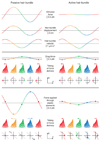Making an effort to listen: mechanical amplification in the ear
- PMID: 18760690
- PMCID: PMC2724262
- DOI: 10.1016/j.neuron.2008.07.012
Making an effort to listen: mechanical amplification in the ear
Abstract
The inner ear's performance is greatly enhanced by an active process defined by four features: amplification, frequency selectivity, compressive nonlinearity, and spontaneous otoacoustic emission. These characteristics emerge naturally if the mechanoelectrical transduction process operates near a dynamical instability, the Hopf bifurcation, whose mathematical properties account for specific aspects of our hearing. The active process of nonmammalian tetrapods depends upon active hair-bundle motility, which emerges from the interaction of negative hair-bundle stiffness and myosin-based adaptation motors. Taken together, these phenomena explain the four characteristics of the ear's active process. In the high-frequency region of the mammalian cochlea, the active process is dominated instead by the phenomenon of electromotility, in which the cell bodies of outer hair cells extend and contract as the protein prestin alters its membrane surface area in response to changes in membrane potential.
Figures







References
-
- Albert JT, Nadrowski B, Gopfert MC. Mechanical signatures of transducer gating in the Drosophila ear. Curr. Biol. 2007;17:1000–1006. - PubMed
-
- Allen JB, Fahey PF. Using acoustic distortion products to measure the cochlear amplifier gain on the basilar membrane. J. Acoust. Soc. Am. 1992;92:178–188. - PubMed
-
- Art JJ, Crawford AC, Fettiplace R, Fuchs PA. Efferent regulation of hair cells in the turtle cochlea. Proc. Roy. Soc. Lond B. 1982;216:377–384. - PubMed
-
- Ashmore J. Cochlear outer hair cell motility. Physiol. Rev. 2008;88:173–210. - PubMed
Publication types
MeSH terms
Grants and funding
LinkOut - more resources
Full Text Sources
Other Literature Sources

